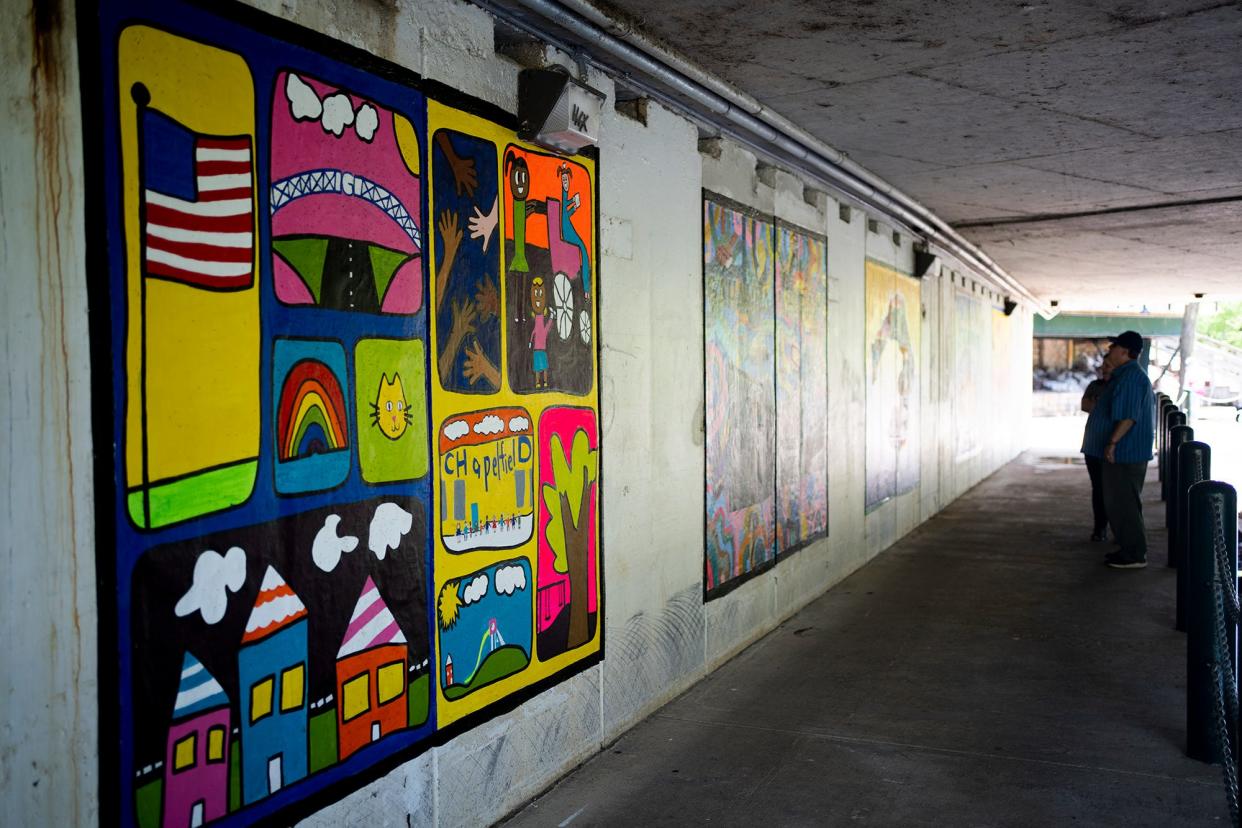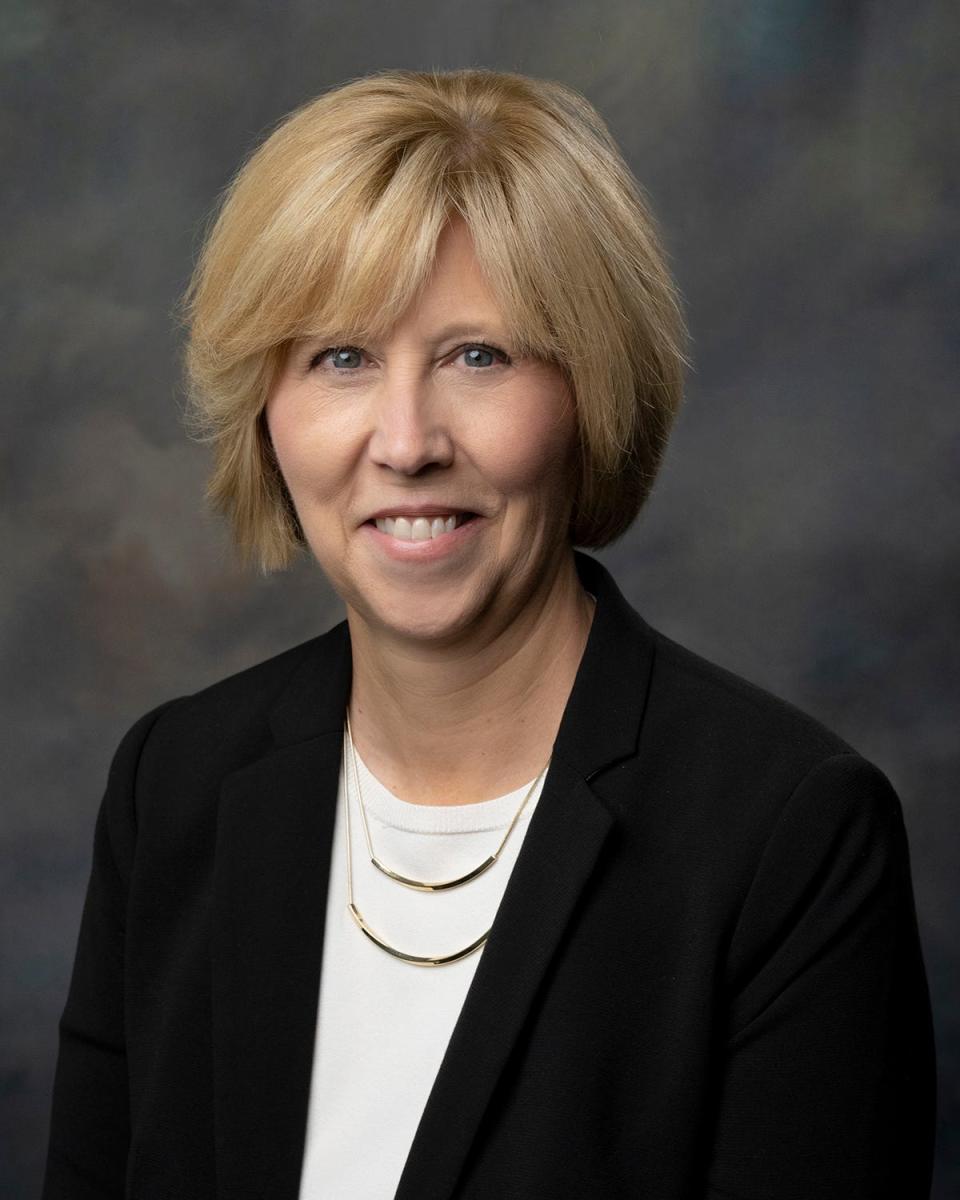Divisive BLM propaganda or innocent artwork: Gahanna kids mural sparks clash

Gahanna City Council narrowly cleared 12 Gahanna-Jefferson student murals to be placed at Creekside Park Monday after some Gahanna residents complained that Black Lives Matter and LGBTQ+ messages in one of the murals amounted to controversial political messaging on city property.
Two of 12 murals submitted by students in various grades in the district were held up over what some said was objectionable content, and some city officials expressing concern the symbols in the mural may open Gahanna to legal liability.
After two weeks of deliberation, Gahanna City Council voted 4-3 during a packed meeting Monday to accept all the murals, which will pave the way for the two controversial ones to be placed at Creekside Park in the coming weeks.
The resolution now is in the hands of Mayor Laurie Jadwin, who can approve or deny the resolution.
Board President Stephen Renner said during the meeting that the "murals in their totality are simply children's vision of how they see Gahanna — loving, helping and caring for all identities."
"Collectively, this is their statement to us," Renner said. "There is no evidence that the symbols could be, or should be, in adult ways. I realize some may have difficulty with this, but we as adults should try to understand our world from their unique and innocent point of view."
Renner voted for including all the murals, and was joined by council members Kaylee Padova, Trenton Weaver and Merisa Bowers. Opposed were council members Michael Schnetzer, Karen Angelou and Nancy McGregor.
Student murals contain BLM poster, Pride flag
The murals in Creekside Park — which are located on a walkway underneath the Granville Street/U.S. 62 bridge over Big Walnut Creek — have historically been done by Gahanna-Jefferson students and needed a refresh as they were last redone in 2007. Gahanna-Jefferson Public School District received permission from the Gahanna Department of Parks and Recreation for a new mural to be designed by local students.
Gahanna Parks and Recreation Foundation, the Gahanna-Jefferson Education Foundation and the Gahanna Area Arts Council donated funds to finance the new murals.
District students, parents and art teachers created new artwork for the murals, which are intended to reflect the Gahanna community. The twelve murals feature common themes such as lions (the district mascot), local landmarks and school buildings and feature such symbols as the American, a cross and a Gahanna police officer.
One mural, at the center of the controversy, depicts a row of schoolchildren linking hands, with the letters on their shirts spelling out "Gahanna." On the far left, one of the children is holding a sign that says BLM (Black Lives Matter) and another is holding up a rainbow flag, which is a symbol of the LGBTQ+ community.

Black Lives Matter is a decentralized political and social movement that seeks to highlight racism, discrimination, and racial inequality experienced by Black people. The movement was formulated in 2013 by three Black women and took off on social media with the hashtag #BlackLivesMatter after George Zimmerman was found not guilty in the 2012 shooting death of Trayvon Martin. It continued to gain prominence with the police killings of more Black people, and gained international prominence in the protests that resulted nationwide, including in Columbus, following the 2020 murder of George Floyd Jr. by then-Minneapolis police officer Derek Chauvin.
Gahanna-Jefferson Superintendent Tracey Deagle said during Monday's meeting that she supported the students' right to express themselves.
"(Gahanna-Jefferson) students are important members of this community — I support our students using artwork to express their perspective and fully affirm their representation of what was created by them to display in our city," Deagle said.
Legal counsel, mayor warn murals could open legal liability
Much of the consternation appeared to be caused by the fact that the city had no policy for accepting submitted artwork, and the students had not been provided guidelines for content other than sharing what they felt reflected the Gahanna community.
City Attorney Raymond Mularski said that if the council passed the resolution, it would effectively become their speech policy and any group seeking to submit their art to the city could seek city council approval. Mularski said the best way to protect the city from liability would be to use the resolution to declare the mural government speech.
More Gahanna news: Gahanna and New Albany residents square off against proposed Sheetz near roundabout
"I do not want you to think I have given you a silver bullet that's going to guarantee that we won't be sued over this," Mularski said.
Jadwin expressed concern about legal liability from allowing possibly political or controversial speech on public property.

"We don't want to subject the city to a lawsuit by doing something incorrectly," Jadwin said. "What this did is shine a light on a policy that we didn't have that we need to have. It was never about students, never about the themes depicted in this, but about the lack of the policy."
Council member Michael Schnetzer said he opposed clearing all the murals because the issue was legal in nature and involved the permanent placement of political messages on city property. He said it was "unwise to take actions that knowingly split the community."
"I don't think a (law degree) is necessary to recognize that we live in a time where, unfortunately, society is very divided," Schnetzer said. "It behooves this council to try and be a unifying force, where we can do so, with the goal of reducing inflaming political passions in our community."
Most residents at meeting supported murals; some called them 'divisive'
Most Gahanna residents who spoke during the meeting were in favor of placing the murals at the park. Many said they were supportive of the messaging or that it would be unfair to deny the artwork when no policy or guidelines had existed.
Resident and parent Paul Bryson said that artwork from new generations always challenges social norms.
"Just as the art of the '60s. the '70s, the '80s, the '90s — of all time — challenged everyone in society and is now embraced," Bryson said. "We have a chance for their art to give us what these kids are showing as the best of themselves."
Others said they disagreed with the artwork and the BLM reference in the one mural, with one resident calling the national movement a "Marxist" organization.
Matthew Murray, a Gahanna resident, said he gets "supporting our students," but called for a compromise.
"Is this, which is divisive, that important — or can we work with each other to discuss what other things we can do to meet the needs of this community?" Murray said.
Chelsea Cellar, an art teacher at Gahanna West Middle School, said it would be good going forward for her students to have a concrete policy about what is allowed in artwork intended for public spaces and what isn't.
"I understand very, very deeply people's concerns with the symbols that were included," Cellar said. "These symbols are symbols of people and who they are intrinsically. I understand that not everybody believes that, but a person's existence, whether they're a person of color or LGBQT+, should not be politicized."
Resolution narrowly passes
Members of the audience applauded after the resolution passed.
The resolution was also amended Monday to accurately reflect the situation about why the city needed to accept the artwork. The initial resolution stated that the city had solicited the artwork, rather than the district receiving permission to use the public space for artwork. During the meeting, member Merisa Bowers said City Council was piecing together what happened in real time, often with developing information.
'We are relying on second-, third- and fourth-hand information in order to determine what actually happened," Bowers said.
Bowers voted in favor of accepting the artwork, saying that "in the absence of written policy, we rely on precedent,” which was to accept the student’s artwork.
Angelou, who voted against the resolution, read a letter from a community member, saying "it does not matter if the artwork was drawn by a toddler, a child, an adolescent or an adult, in the event the artwork is politically charged in any way, it will be inherently divisive."
@Colebehr_report
Cbehrens@dispatch.com
This article originally appeared on The Columbus Dispatch: Gahanna student mural sparks clash over BLM, LGBTQ+ inclusion

